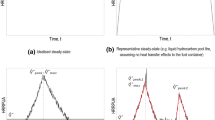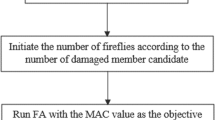Abstract
In the Netherlands most murder victims are found 2–24 h after the crime. During this period, body temperature decrease is the most reliable method to estimate the postmortem time (PMT). Recently, two murder cases were analysed in which currently available methods did not provide a sufficiently reliable estimate of the PMT. In both cases a study was performed to verify the statements of suspects. For this purpose a finite-element computer model was developed that simulates a human torso and its clothing. With this model, changes to the body and the environment can also be modelled; this was very relevant in one of the cases, as the body had been in the presence of a small fire. In both cases it was possible to falsify the statements of the suspects by improving the accuracy of the PMT estimate. The estimated PMT in both cases was within the range of Henssge’s model. The standard deviation of the PMT estimate was 35 min in the first case and 45 min in the second case, compared to 168 min (2.8 h) in Henssge’s model. In conclusion, the model as presented here can have additional value for improving the accuracy of the PMT estimate. In contrast to the simple model of Henssge, the current model allows for increased accuracy when more detailed information is available. Moreover, the sensitivity of the predicted PMT for uncertainty in the circumstances can be studied, which is crucial to the confidence of the judge in the results.


Similar content being viewed by others
References
Henssge C (1992) Rectal temperature time of death Nomogram: dependence of corrective factors on the body weight under stronger thermic isolation conditions. Forensic Sci Int 54:51–66
Henssge C, Knight B, Krompecher T, Madea B, Nokes L (1995) In: Knight B (ed) The estimation of the time since death in the early postmortem period. Arnold, London
Incropera FP, De Witt DP (1990) Fundamentals of heat and mass transfer, 3rd edn. Wiley, New York
Lehmann JF (1990) Therapeutic heat and cold, 4th edn. Williams and Wilkins, Baltimore
Lotens WA (1993) Heat transfer from humans wearing clothing. PhD thesis, Technical University Delft, The Netherlands
Lynnerup N (1993) A computer program for the estimation of time of death. J Forensic Sci 38(4):816–820
Mead J, Bonmarito CL (1949) Reliability of rectal temperature as an index of internal body temperature. J Appl Physiol 2:97–109
Parsons KC (1993) Human thermal environments. Taylor and Francis, London
Sinclair D (1978) Human growth after birth, 3rd edn. Oxford University Press, London
Author information
Authors and Affiliations
Corresponding author
Additional information
This work is based on the confidential reports TNO-TM-98-M57 and TNO-TM-00-C032 (in Dutch) to the specific forensic forces of the Dutch police
Rights and permissions
About this article
Cite this article
den Hartog, E.A., Lotens, W.A. Postmortem time estimation using body temperature and a finite-element computer model. Eur J Appl Physiol 92, 734–737 (2004). https://doi.org/10.1007/s00421-004-1128-z
Accepted:
Published:
Issue Date:
DOI: https://doi.org/10.1007/s00421-004-1128-z




